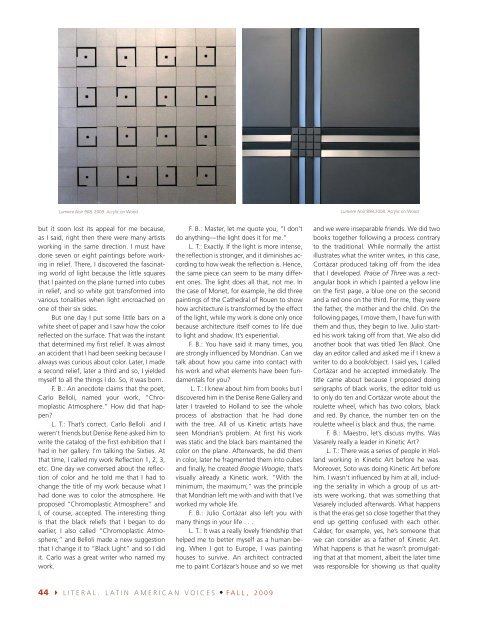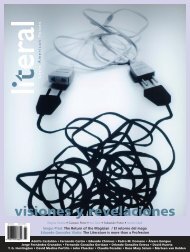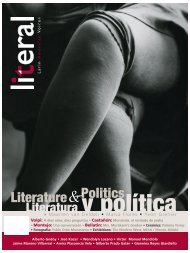Giobany Arévalo > Gabriela Torres Olivares >Anuar Jalife - Literal
Giobany Arévalo > Gabriela Torres Olivares >Anuar Jalife - Literal
Giobany Arévalo > Gabriela Torres Olivares >Anuar Jalife - Literal
You also want an ePaper? Increase the reach of your titles
YUMPU automatically turns print PDFs into web optimized ePapers that Google loves.
Lumiere Noir 908, 2009. Acrylic on Wood Lumiere Noir 898,2008. Acrylic on Wood<br />
but it soon lost its appeal for me because,<br />
as I said, right then there were many artists<br />
working in the same direction. I must have<br />
done seven or eight paintings before working<br />
in relief. There, I discovered the fascinating<br />
world of light because the little squares<br />
that I painted on the plane turned into cubes<br />
in relief, and so white got transformed into<br />
various tonalities when light encroached on<br />
one of their six sides.<br />
But one day I put some little bars on a<br />
white sheet of paper and I saw how the color<br />
refl ected on the surface. That was the instant<br />
that determined my fi rst relief. It was almost<br />
an accident that I had been seeking because I<br />
always was curious about color. Later, I made<br />
a second relief, later a third and so, I yielded<br />
myself to all the things I do. So, it was born.<br />
F. B.: An anecdote claims that the poet,<br />
Carlo Belloli, named your work, “Chromoplastic<br />
Atmosphere.” How did that happen?<br />
L. T.: That’s correct. Carlo Belloli and I<br />
weren’t friends but Denise Rene asked him to<br />
write the catalog of the fi rst exhibition that I<br />
had in her gallery. I’m talking the Sixties. At<br />
that time, I called my work Refl ection 1, 2, 3,<br />
etc. One day we conversed about the refl ection<br />
of color and he told me that I had to<br />
change the title of my work because what I<br />
had done was to color the atmosphere. He<br />
proposed “Chromoplastic Atmosphere” and<br />
I, of course, accepted. The interesting thing<br />
is that the black reliefs that I began to do<br />
earlier, I also called “Chromoplastic Atmosphere,”<br />
and Belloli made a new suggestion<br />
that I change it to “Black Light” and so I did<br />
it. Carlo was a great writer who named my<br />
work.<br />
F. B.: Master, let me quote you, “I don’t<br />
do anything—the light does it for me.”<br />
L. T.: Exactly. If the light is more intense,<br />
the refl ection is stronger, and it diminishes according<br />
to how weak the refl ection is. Hence,<br />
the same piece can seem to be many different<br />
ones. The light does all that, not me. In<br />
the case of Monet, for example, he did three<br />
paintings of the Cathedral of Rouen to show<br />
how architecture is transformed by the effect<br />
of the light, while my work is done only once<br />
because architecture itself comes to life due<br />
to light and shadow. It’s experiential.<br />
F. B.: You have said it many times, you<br />
are strongly infl uenced by Mondrian. Can we<br />
talk about how you came into contact with<br />
his work and what elements have been fundamentals<br />
for you?<br />
L. T.: I knew about him from books but I<br />
discovered him in the Denise Rene Gallery and<br />
later I traveled to Holland to see the whole<br />
process of abstraction that he had done<br />
with the tree. All of us Kinetic artists have<br />
seen Mondrian’s problem. At fi rst his work<br />
was static and the black bars maintained the<br />
color on the plane. Afterwards, he did them<br />
in color, later he fragmented them into cubes<br />
and fi nally, he created Boogie Woogie, that’s<br />
visually already a Kinetic work. “With the<br />
minimum, the maximum,” was the principle<br />
that Mondrian left me with and with that I’ve<br />
worked my whole life.<br />
F. B.: Julio Cortázar also left you with<br />
many things in your life . . .<br />
L. T.: It was a really lovely friendship that<br />
helped me to better myself as a human being.<br />
When I got to Europe, I was painting<br />
houses to survive. An architect contracted<br />
me to paint Cortázar’s house and so we met<br />
44 LITERAL. LATIN AMERICAN VOICES FALL, 2009<br />
and we were inseparable friends. We did two<br />
books together following a process contrary<br />
to the traditional. While normally the artist<br />
illustrates what the writer writes, in this case,<br />
Cortázar produced taking off from the idea<br />
that I developed. Praise of Three was a rectangular<br />
book in which I painted a yellow line<br />
on the fi rst page, a blue one on the second<br />
and a red one on the third. For me, they were<br />
the father, the mother and the child. On the<br />
following pages, I move them, I have fun with<br />
them and thus, they begin to live. Julio started<br />
his work taking off from that. We also did<br />
another book that was titled Ten Black. One<br />
day an editor called and asked me if I knew a<br />
writer to do a book/object. I said yes, I called<br />
Cortázar and he accepted immediately. The<br />
title came about because I proposed doing<br />
serigraphs of black works, the editor told us<br />
to only do ten and Cortázar wrote about the<br />
roulette wheel, which has two colors, black<br />
and red. By chance, the number ten on the<br />
roulette wheel is black and thus, the name.<br />
F. B.: Maestro, let’s discuss myths. Was<br />
Vasarely really a leader in Kinetic Art?<br />
L. T.: There was a series of people in Holland<br />
working in Kinetic Art before he was.<br />
Moreover, Soto was doing Kinetic Art before<br />
him. I wasn’t infl uenced by him at all, including<br />
the seriality in which a group of us artists<br />
were working, that was something that<br />
Vasarely included afterwards. What happens<br />
is that the eras get so close together that they<br />
end up getting confused with each other.<br />
Calder, for example, yes, he’s someone that<br />
we can consider as a father of Kinetic Art.<br />
What happens is that he wasn’t promulgating<br />
that at that moment, albeit the later time<br />
was responsible for showing us that quality






